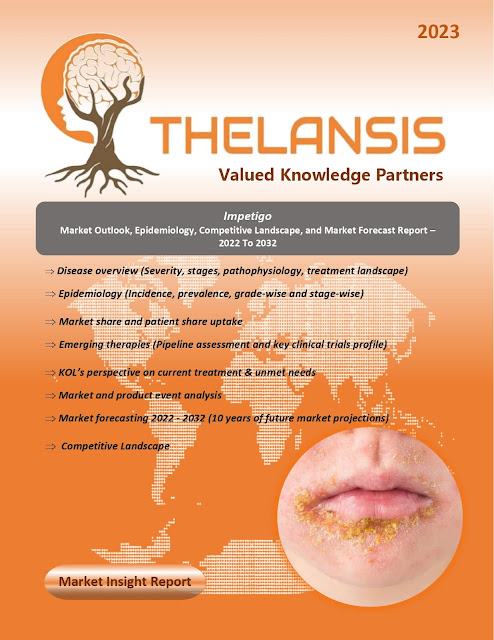Impetigo – Market Outlook, Epidemiology, Competitive Landscape, and Market Forecast Report – 2022 To 2032
Impetigo, a prevalent infection of the superficial layers of the epidermis, is characterized by its high contagiousness and is primarily induced by gram-positive bacteria. The typical presentation involves erythematous plaques covered with a yellow crust, often accompanied by itching or pain. The infectious lesions easily spread, posing a significant contagion risk. This condition primarily affects children residing in hot and humid climates. Impetigo can manifest as either bullous or nonbullous variants. Although it commonly afflicts the facial region, it can emerge on any body area with abrasions, lacerations, insect bites, or other forms of trauma. Among pediatric skin issues, impetigo contributes to roughly 10% of cases. The incidence is equitable between genders across all age groups, but it predominantly affects males in adults. While most prevalent among 2 to 5-year-old children, impetigo can develop at any age, with the highest occurrence during the summer and fall. Bullous impetigo is particularly frequent among infants, with those under two years old constituting 90% of bullous impetigo cases. Impetigo can be categorized as either primary or secondary. The former involves the direct bacterial invasion of previously healthy skin, while the latter is triggered by infection at a prior site of skin injury. The disruption of the skin barrier provides GABHS and S. aureus access to fibronectin receptors, essential for their colonization. Common mechanisms leading to skin breakdown include trauma, cuts, insect bites, surgery, atopic dermatitis, burns, and varicella. Once a lesion is present, self-inoculation to other sites frequently occurs. Factors such as malnutrition, immunosuppression, daycare attendance, overcrowding, diabetes, and poor hygiene heighten susceptibility to impetigo. Various triggers can compromise the skin's integrity and make individuals more prone to impetigo:
·
Varicella
·
Herpes
·
Scratching
·
Lice
·
Burns
·
Trauma
·
Insect bites
Impetigo is commonly managed with
topical antibiotics, alone or combined with systemic antibiotics. Effective
treatment should address both S. aureus and GABHS. While impetigo can resolve
independently, antibiotic therapy accelerates recovery, minimizes illness
duration, and curbs lesion spread. Moreover, antibiotic intervention reduces
the risk of complications involving organs like the kidneys, joints, bones, and
lungs and the development of acute rheumatic fever. Topical treatment is the
preferred approach for localized, uncomplicated, nonbullous impetigo. Before
applying topical antibiotics like mupirocin, retapamulin, or fusidic acid,
cleaning the area and removing crusts with soap and water are recommended.
Untreated impetigo typically resolves within 14-21 days, with around 20% of
cases spontaneously clearing up. While scarring is infrequent, some patients
may experience changes in pigmentation or develop ecthyma. With treatment,
complete recovery is achievable within 10 days. Neonates are at risk of developing
meningitis. An uncommon complication, acute post-streptococcal
glomerulonephritis, can arise 2-3 weeks after the skin infection. While most
patients show improvement with treatment, a small subset might experience renal
failure, particularly if the infection stems from streptococcus. Renal
dysfunction tends to emerge 7-14 days after infection. Transient hematuria and
proteinuria might persist for a few weeks or months. Other potential
complications encompass septic arthritis, scarlet fever, sepsis, and
staphylococcal scalded skin syndrome.
·
In the United States, impetigo is more
prevalent during the summer months. The World Health Organization also
approximates that approximately 111 million children in less developed nations
are simultaneously affected by streptococcal impetigo. Elevated incidences of
impetigo are observed in densely populated and economically disadvantaged
environments, especially under warm and humid climatic conditions, as well as
within communities characterized by suboptimal hygiene practices.
Thelansis’s “Impetigo Market Outlook,
Epidemiology, Competitive Landscape, and Market Forecast Report – 2022 To
2032" covers disease overview, epidemiology, drug utilization,
prescription share analysis, competitive landscape, clinical practice,
regulatory landscape, patient share, market uptake, market forecast, and key
market insights under the potential Impetigo treatment modalities options for
eight major markets (USA, Germany, France, Italy, Spain, UK, Japan, and China).
KOLs insights
of Impetigo across 8 MM market from the centre of Excellence/ Public/ Private
hospitals participated in the study. Insights around current treatment
landscape, epidemiology, clinical characteristics, future treatment paradigm,
and Unmet needs.
Impetigo Market Forecast Patient
Based Forecast Model (MS. Excel Based Automated Dashboard), which Data Inputs
with sourcing, Market Event, and Product Event, Country specific Forecast
Model, Market uptake and patient share uptake, Attribute Analysis, Analog
Analysis, Disease burden, and pricing scenario, Summary, and Insights.
Thelansis Competitive Intelligence (CI) practice
has been established based on a deep understanding of the pharma/biotech
business environment to provide an optimized support system to all levels of
the decision-making process. It enables business leaders in forward-thinking
and proactive decision-making. Thelansis supports scientific and commercial
teams in seamless CI support by creating an AI/ ML-based technology-driven
platform that manages the data flow from primary and secondary sources.




Comments
Post a Comment